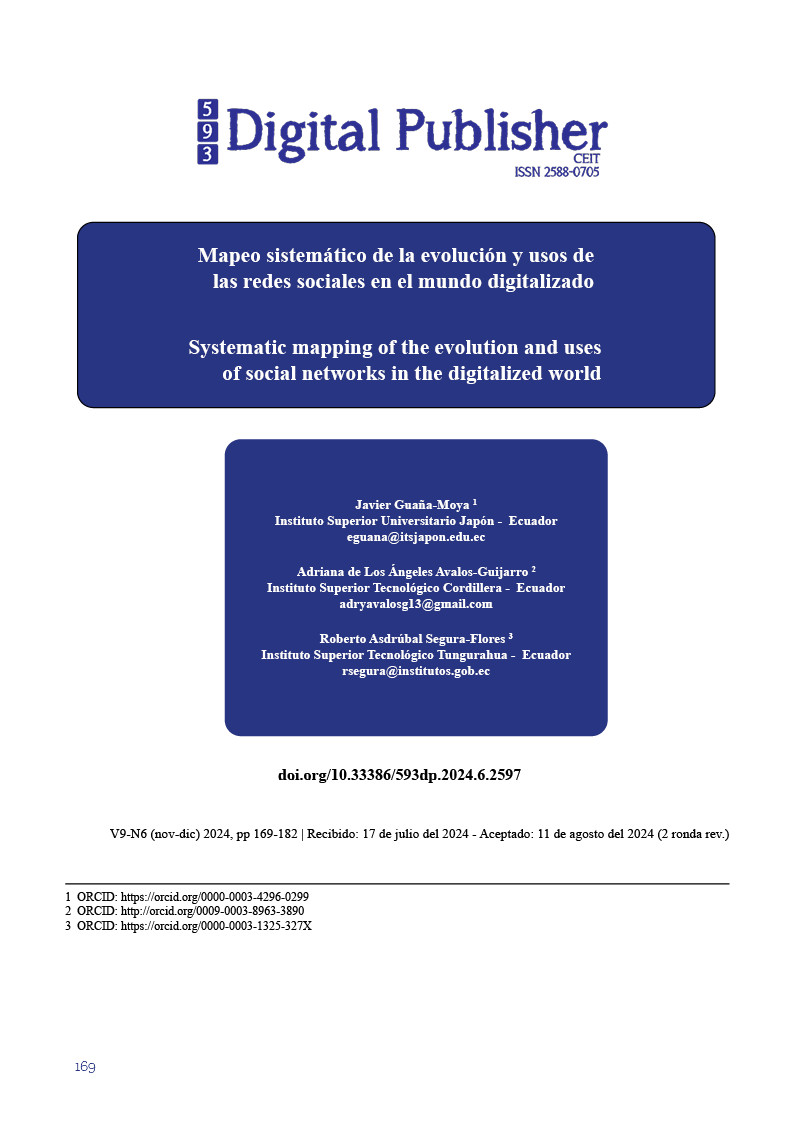Systematic mapping of the evolution and uses of social networks in the digitalized world
Main Article Content
Abstract
Social media has significantly transformed the way information is communicated and distributed in the digital age, making it easier to interact quickly and easily. This study aims to systematically map the evolution and uses of social networks, analyzing their impact on today’s society, focusing on their origins, development and applications in various human activities. A qualitative methodology was adopted which included a systematic review of the literature, which covered planning, searching and analysis of relevant studies. The findings highlight an evolution from simple platforms to complex digital ecosystems, which have moved from communication tools to multifunctional platforms integrating entertainment and e-commerce. Algorithm-based personalization has changed the user experience, creating information bubbles while making content more relevant. Social media has influenced the formation of social movements and opinions, but it faces challenges such as the proliferation of fake news and privacy and security issues. Future trends suggest a greater role for emerging technologies such as virtual reality, artificial intelligence and blockchain, which could redefine online interactions and cultural globalization.
Downloads
Article Details

This work is licensed under a Creative Commons Attribution-NonCommercial-ShareAlike 4.0 International License.
1. Derechos de autor
Las obras que se publican en 593 Digital Publisher CEIT están sujetas a los siguientes términos:
1.1. 593 Digital Publisher CEIT, conserva los derechos patrimoniales (copyright) de las obras publicadas, favorece y permite la reutilización de las mismas bajo la licencia Licencia Creative Commons 4.0 de Reconocimiento-NoComercial-CompartirIgual 4.0, por lo cual se pueden copiar, usar, difundir, transmitir y exponer públicamente, siempre que:
1.1.a. Se cite la autoría y fuente original de su publicación (revista, editorial, URL).
1.1.b. No se usen para fines comerciales u onerosos.
1.1.c. Se mencione la existencia y especificaciones de esta licencia de uso.
References
Ahmadfaizar. (2018, August 13). Evolution of The Web: Web 1.0, web 2.0, web 3.0, web 4.0, web 5.0 and beyond. Evolution of The Web. http://ahmadfaizar.blogspot.com/2018/08/evolution-of-web-web-10-web-20-web-30.html
Ahmadfaizar. (2018, August 13). Evolution of The Web: Web 1.0, web 2.0, web 3.0, web 4.0, web 5.0 and beyond. Evolution of The Web. http://ahmadfaizar.blogspot.com/2018/08/evolution-of-web-web-10-web-20-web-30.html
Altamirano-Pazmiño, M., et al. (2022). Uso de las herramientas digitales en la educación virtual en Ecuador. Revista Ibérica de Sistemas e Tecnologias de Informação, E54, 194-202.
Anderson, B., Fagan, P., Woodnutt, T., & Chamorro-Premuzic, T. (2012). Facebook psychology: Popular questions answered by research. Psychology of Popular Media Culture, 1(1), 23-37. https://doi.org/10.1037/a0026452
Auxier, B., & Anderson, M. (2021). Social Media Use in 2021. Pew Research Center. https://www.pewresearch.org/internet/wp-content/uploads/sites/9/2021/04/PI_2021.04.07_Social-Media-Use_FINAL.pdf
Azak, A., Sulak, S. A., & Güner, H. E. (2020). Analysis of University Students’ Views and Usage Levels of Web 2.0 Tools in Terms of Various Variables. International Journal of Academic Research in Business and Social Sciences, 10(6), 609-623. https://doi.org/10.6007/IJARBSS/v10-i6/7336
Benito-Osorio, D., Peris-Ortiz, M., Armengot, C. R., & Colino, A. (2013). Web 5.0: The future of emotional competences in higher education. Global Business Perspectives, 1(3), 274-287. https://doi.org/10.1007/s40196-013-0016-5
Bolton, R. N., Parasuraman, A., Hoefnagels, A., Migchels, N., Kabadayi, S., Gruber, T., ... & Solnet, D. (2013). Understanding Generation Y and their use of social media: A review and research agenda. Journal of Service Management, 24(3), 245-267. https://doi.org/10.1108/09564231311326987
Bughin, J. (2007). How companies can make the most of user-generated content. The McKinsey Quarterly. http://www0.cs.ucl.ac.uk/staff/d.quercia/others/ugc.pdf
Carr, C. T., & Hayes, R. A. (2015). Social Media: Defining, Developing, and Divining. Atlantic Journal of Communication, 23(1), 46-65. https://doi.org/10.1080/15456870.2015.972282
De Castro, C. A., O’Reilly, I., & Carthy, A. (2022). The Evolution of the Internet and Social Media: A Literature Review. International Journal of Emerging Electronics and Engineering, 12(1), 30-41. https://doi.org/10.17706/ijeeee.2022.12.1.30-41
Edosomwan, S., Prakasan, S. K., Kouame, D., Watson, J., & Seymour, T. (2011). The history of social media and its impact on business. Journal of Applied Management and Entrepreneurship, 16(1), 79-91.
Effing, R., van Hillegersberg, J., & Huibers, T. (2011). Social Media and Political Participation: Are Facebook, Twitter and YouTube Democratizing Our Political Systems? In Electronic Participation (pp. 25-35). Springer. https://doi.org/10.1007/978-3-642-23333-3_3
Guaña-Moya, J., et al. (2022). Impact of ICTs on academic development and the creation of educational public policies in times of pandemic. En 17th Iberian Conference on Information Systems and Technologies (CISTI). IEEE. https://doi.org/10.1109/CISTI52337.2022.00000
Hanna, R., Rohm, A., & Crittenden, V. L. (2011). We’re all connected: The power of the social media ecosystem. Business Horizons, 54(3), 265-273. https://doi.org/10.1016/j.bushor.2011.01.007
Herrera, H. H. (2012). Las redes sociales: una nueva herramienta de difusión [Social networks: a new diffusion tool]. Reflexiones, 91(2), 121-128.
Hines, K. (2022, September 2). The History Of Social Media. Search Engine Journal. https://www.searchenginejournal.com/social-media-history/462643/
Howard, P. N., & Parks, M. R. (2012). Social Media and Political Change: Capacity, Constraint, and Consequence. Journal of Communication, 62(2), 359-362. https://doi.org/10.1111/j.1460-2466.2012.01626.x
Huerta, A. E. (2022). El impacto de las redes sociales en el aprendizaje colaborativo: Caso de estudio en educación secundaria. Revista Ingenio Global, 1(1), 15-25.
Ilbay, E. L. (2022). Estrategias para promover la alfabetización mediática en la era digital. Bastcorp International Journal, 1(1), 14-22.
Jiménez, R. G.-A., Bravo, C. B., & Ilardia, I. M. P. (2020). Uso de las redes sociales entre los jóvenes y ciudadanía digital: análisis tras la COVID-19. REIDICS. Revista de Investigación en Didáctica de las Ciencias Sociales, 7(Art. 7). https://doi.org/10.17398/2531-0968.07.64
Jordán-Conde, Z., Mennecke, B., & Townsend, A. (2014). Late adolescent identity definition and intimate disclosure on Facebook. Computers in Human Behavior, 33, 356-366. https://doi.org/10.1016/j.chb.2013.07.015
Kaplan, A. M., & Haenlein, M. (2010). Users of the world, unite! The challenges and opportunities of Social Media. Business Horizons, 53(1), 59-68. https://doi.org/10.1016/j.bushor.2009.09.003
Kettemann, M. C., & Schulz, W. (2020). Setting Rules for 2.7 billion: A (First) Look into Facebook’s Norm-Making System; Results of a Pilot Study. Working Papers of the Hans-Bredow-Institut | Works in Progress. https://doi.org/10.21241/SSOAR.71724
Kitchenham, B., Pearl Brereton, O., Budgen, D., Turner, M., Bailey, J., & Linkman, S. (2009). Systematic literature reviews in software engineering – A systematic literature review. Information and Software Technology, 51(1), 7-15. https://doi.org/10.1016/j.infsof.2008.09.009
Krishnamurthy, S., & Dou, W. (2008). Note from Special Issue Editors. Journal of Interactive Advertising, 8(1), 1-4. https://doi.org/10.1080/15252019.2008.10722137
Landman, M. P., Shelton, J., Kauffmann, R. M., & Dattilo, J. B. (2010). Guidelines for maintaining a professional compass in the era of social networking. Journal of Surgical Education, 67(6), 381-386. https://doi.org/10.1016/j.jsurg.2010.07.006
Malesky, L. A., & Peters, C. (2012). Defining appropriate professional behavior for faculty and university students on social networking websites. Higher Education, 63(1), 135-151. https://doi.org/10.1007/s10734-011-9452-7
Mangal, V., & Gadh, V. (2013). Systems Theory and Social Networking: Investigation of Systems Theory principles in Web 2.0 Social Network Systems. International Journal of Business and Commerce, 3(1), 117-135.
Méndez-Diaz, N., Akabr, G., & Parker-Barnes, L. (2022). The Evolution of Social Media and the Impact on Modern Therapeutic Relationships. The Family Journal, 30(1), 59-66. https://doi.org/10.1177/10664807211052495
Molina, S. P. (2022). Estrategias de marketing en redes sociales: Influencia en el comportamiento del consumidor. Revista Científica Kosmos, 1(1), 4-14.
Palfrey, J., & Gasser, U. (2010). Born Digital: Understanding the First Generation of Digital Natives. New York: Basic Books.
Park, N., Kee, K., & Valenzuela, S. (2009). Being immersed in social networking environment: Facebook Groups, uses and gratifications, and social outcomes. Cyberpsychology & Behavior, 12(6), 729-733. https://doi.org/10.1089/cpb.2009.0003
Pempek, T. A., Yermolayeva, Y. A., & Calvert, S. L. (2009). College students’ social networking experiences on Facebook. Journal of Applied Developmental Psychology, 30(3), 227-238. https://doi.org/10.1016/j.appdev.2008.12.010
Pennington, N. (2021). Quitting social media: A qualitative exploration of communication outcomes. Qualitative Research Reports in Communication, 22(1), 30-38. https://doi.org/10.1080/17459435.2020.1817140
Rawlins, J. M., Simeon, D. T., Ramdath, D. D., & Chadee, D. D. (2008). The elderly in Trinidad: Health, social and economic status and issues of loneliness. West Indian Medical Journal, 57(6), 589-595.
Ruiz, F. C. (2023). Herramientas digitales para fomentar la alfabetización mediática en la era digital. Revista Ingenio Global, 2(1), 35-45.
Shao, G. (2009). Understanding the appeal of user‐generated media: A uses and gratification perspective. Internet Research, 19(1), 7-25. https://doi.org/10.1108/10662240910927795
Shim, J., & Ahn, K. (2011). Social Networking Service: Motivation, Pleasure, and Behavioral Intention to Use. Journal of Computer Information Systems, 51(1), 92-101.
Soelaiman, L., & Ekawati, S. (2022). The Role of Social Media in Enhancing Business Performance. En Tenth International Conference on Entrepreneurship and Business Management 2021 (ICEBM 2021), 400-404. https://doi.org/10.2991/aebmr.k.220501.060
Spies Shapiro, L. A., & Margolin, G. (2014). Growing up wired: Social networking sites and adolescent psychosocial development. Clinical Child and Family Psychology Review, 17(1), 1-18. https://doi.org/10.1007/s10567-013-0135-1
Terry, M. (2009). Twittering Healthcare: Social Media and Medicine. Telemedicine and e-Health, 15(6), 507-510. https://doi.org/10.1089/tmj.2009.9955
Twenge, J. M., Martin, G. N., & Spitzberg, B. H. (2019). Trends in U.S. adolescents’ media use, 1976–2016: The rise of digital media, the decline of TV, and the (near) demise of print. Psychology of Popular Media Culture, 8(4), 329-345. https://doi.org/10.1037/ppm0000203
Xiang, Z., & Gretzel, U. (2010). Role of social media in online travel information search. Tourism Management, 31(2), 179-188. https://doi.org/10.1016/j.tourman.2009.02.016
Zhang, Z., & Gupta, B. B. (2018). Social media security and trustworthiness: Overview and new direction. Future Generation Computer Systems, 86, 914-925. https://doi.org/10.1016/j.future.2016.10.007
Ñaupas Paitán, H., Mejía Mejía, E., Trujillo Román, I. R., & Romero Delgado, H. E. (2023). Metodología de la investigación total. Cuantitativa – Cualitativa y redacción de tesis (6ª ed.). Ediciones de la U.




